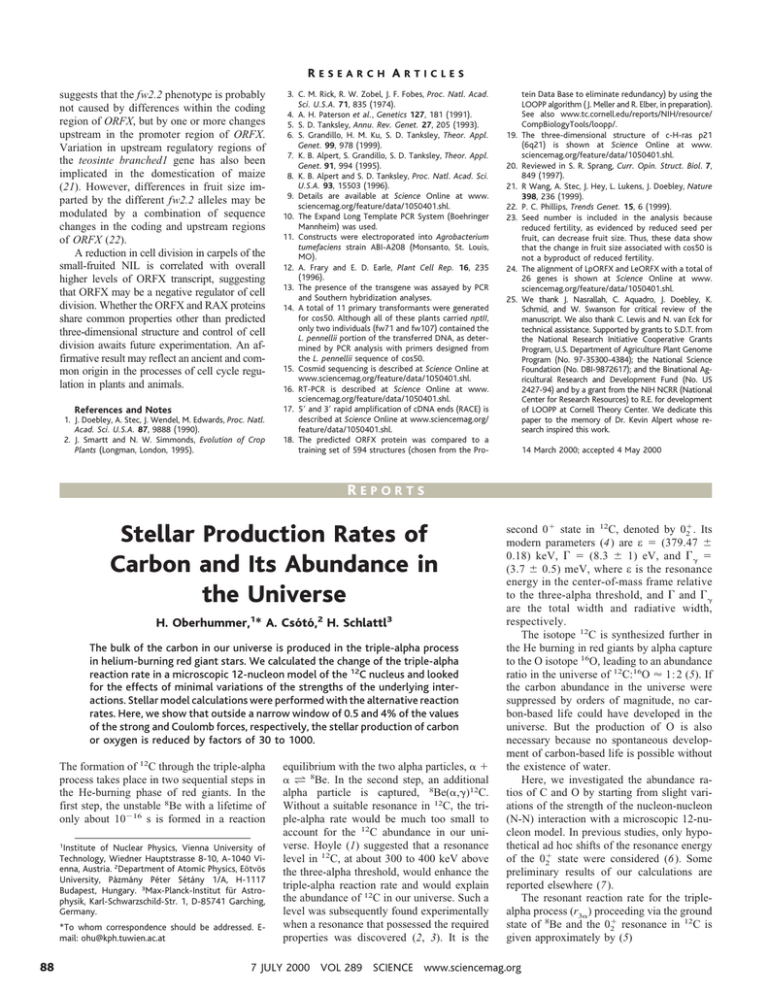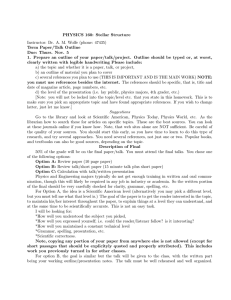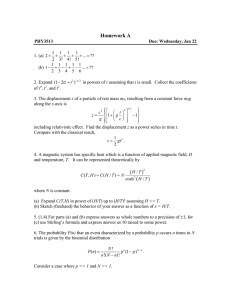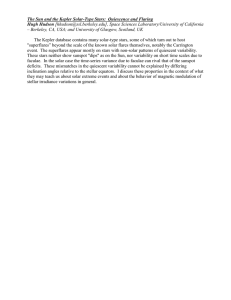fw2.2
advertisement

RESEARCH ARTICLES
suggests that the fw2.2 phenotype is probably
not caused by differences within the coding
region of ORFX, but by one or more changes
upstream in the promoter region of ORFX.
Variation in upstream regulatory regions of
the teosinte branched1 gene has also been
implicated in the domestication of maize
(21). However, differences in fruit size imparted by the different fw2.2 alleles may be
modulated by a combination of sequence
changes in the coding and upstream regions
of ORFX (22).
A reduction in cell division in carpels of the
small-fruited NIL is correlated with overall
higher levels of ORFX transcript, suggesting
that ORFX may be a negative regulator of cell
division. Whether the ORFX and RAX proteins
share common properties other than predicted
three-dimensional structure and control of cell
division awaits future experimentation. An affirmative result may reflect an ancient and common origin in the processes of cell cycle regulation in plants and animals.
References and Notes
1. J. Doebley, A. Stec, J. Wendel, M. Edwards, Proc. Natl.
Acad. Sci. U.S.A. 87, 9888 (1990).
2. J. Smartt and N. W. Simmonds, Evolution of Crop
Plants (Longman, London, 1995).
3. C. M. Rick, R. W. Zobel, J. F. Fobes, Proc. Natl. Acad.
Sci. U.S.A. 71, 835 (1974).
4. A. H. Paterson et al., Genetics 127, 181 (1991).
5. S. D. Tanksley, Annu. Rev. Genet. 27, 205 (1993).
6. S. Grandillo, H. M. Ku, S. D. Tanksley, Theor. Appl.
Genet. 99, 978 (1999).
7. K. B. Alpert, S. Grandillo, S. D. Tanksley, Theor. Appl.
Genet. 91, 994 (1995).
8. K. B. Alpert and S. D. Tanksley, Proc. Natl. Acad. Sci.
U.S.A. 93, 15503 (1996).
9. Details are available at Science Online at www.
sciencemag.org/feature/data/1050401.shl.
10. The Expand Long Template PCR System (Boehringer
Mannheim) was used.
11. Constructs were electroporated into Agrobacterium
tumefaciens strain ABI-A208 (Monsanto, St. Louis,
MO).
12. A. Frary and E. D. Earle, Plant Cell Rep. 16, 235
(1996).
13. The presence of the transgene was assayed by PCR
and Southern hybridization analyses.
14. A total of 11 primary transformants were generated
for cos50. Although all of these plants carried nptII,
only two individuals (fw71 and fw107) contained the
L. pennellii portion of the transferred DNA, as determined by PCR analysis with primers designed from
the L. pennellii sequence of cos50.
15. Cosmid sequencing is described at Science Online at
www.sciencemag.org/feature/data/1050401.shl.
16. RT-PCR is described at Science Online at www.
sciencemag.org/feature/data/1050401.shl.
17. 5⬘ and 3⬘ rapid amplification of cDNA ends (RACE) is
described at Science Online at www.sciencemag.org/
feature/data/1050401.shl.
18. The predicted ORFX protein was compared to a
training set of 594 structures (chosen from the Pro-
19.
20.
21.
22.
23.
24.
25.
tein Data Base to eliminate redundancy) by using the
LOOPP algorithm ( J. Meller and R. Elber, in preparation).
See also www.tc.cornell.edu/reports/NIH/resource/
CompBiologyTools/loopp/.
The three-dimensional structure of c-H-ras p21
(6q21) is shown at Science Online at www.
sciencemag.org/feature/data/1050401.shl.
Reviewed in S. R. Sprang, Curr. Opin. Struct. Biol. 7,
849 (1997).
R Wang, A. Stec, J. Hey, L. Lukens, J. Doebley, Nature
398, 236 (1999).
P. C. Phillips, Trends Genet. 15, 6 (1999).
Seed number is included in the analysis because
reduced fertility, as evidenced by reduced seed per
fruit, can decrease fruit size. Thus, these data show
that the change in fruit size associated with cos50 is
not a byproduct of reduced fertility.
The alignment of LpORFX and LeORFX with a total of
26 genes is shown at Science Online at www.
sciencemag.org/feature/data/1050401.shl.
We thank J. Nasrallah, C. Aquadro, J. Doebley, K.
Schmid, and W. Swanson for critical review of the
manuscript. We also thank C. Lewis and N. van Eck for
technical assistance. Supported by grants to S.D.T. from
the National Research Initiative Cooperative Grants
Program, U.S. Department of Agriculture Plant Genome
Program (No. 97-35300-4384); the National Science
Foundation (No. DBI-9872617); and the Binational Agricultural Research and Development Fund (No. US
2427-94) and by a grant from the NIH NCRR (National
Center for Research Resources) to R.E. for development
of LOOPP at Cornell Theory Center. We dedicate this
paper to the memory of Dr. Kevin Alpert whose research inspired this work.
14 March 2000; accepted 4 May 2000
REPORTS
Stellar Production Rates of
Carbon and Its Abundance in
the Universe
H. Oberhummer,1* A. Csótó,2 H. Schlattl3
The bulk of the carbon in our universe is produced in the triple-alpha process
in helium-burning red giant stars. We calculated the change of the triple-alpha
reaction rate in a microscopic 12-nucleon model of the 12C nucleus and looked
for the effects of minimal variations of the strengths of the underlying interactions. Stellar model calculations were performed with the alternative reaction
rates. Here, we show that outside a narrow window of 0.5 and 4% of the values
of the strong and Coulomb forces, respectively, the stellar production of carbon
or oxygen is reduced by factors of 30 to 1000.
The formation of 12C through the triple-alpha
process takes place in two sequential steps in
the He-burning phase of red giants. In the
first step, the unstable 8Be with a lifetime of
only about 10⫺16 s is formed in a reaction
1
Institute of Nuclear Physics, Vienna University of
Technology, Wiedner Hauptstrasse 8-10, A-1040 Vienna, Austria. 2Department of Atomic Physics, Eötvös
University, Pázmány Péter Sétány 1/A, H-1117
Budapest, Hungary. 3Max-Planck-Institut für Astrophysik, Karl-Schwarzschild-Str. 1, D-85741 Garching,
Germany.
*To whom correspondence should be addressed. Email: ohu@kph.tuwien.ac.at
88
equilibrium with the two alpha particles, ␣ ⫹
␣ º 8Be. In the second step, an additional
alpha particle is captured, 8Be(␣,␥)12C.
Without a suitable resonance in 12C, the triple-alpha rate would be much too small to
account for the 12C abundance in our universe. Hoyle (1) suggested that a resonance
level in 12C, at about 300 to 400 keV above
the three-alpha threshold, would enhance the
triple-alpha reaction rate and would explain
the abundance of 12C in our universe. Such a
level was subsequently found experimentally
when a resonance that possessed the required
properties was discovered (2, 3). It is the
second 0⫹ state in 12C, denoted by 0⫹
2 . Its
modern parameters (4) are ε ⫽ (379.47 ⫾
0.18) keV, ⌫ ⫽ (8.3 ⫾ 1) eV, and ⌫␥ ⫽
(3.7 ⫾ 0.5) meV, where ε is the resonance
energy in the center-of-mass frame relative
to the three-alpha threshold, and ⌫ and ⌫␥
are the total width and radiative width,
respectively.
The isotope 12C is synthesized further in
the He burning in red giants by alpha capture
to the O isotope 16O, leading to an abundance
ratio in the universe of 12C:16O ⬇ 1: 2 (5). If
the carbon abundance in the universe were
suppressed by orders of magnitude, no carbon-based life could have developed in the
universe. But the production of O is also
necessary because no spontaneous development of carbon-based life is possible without
the existence of water.
Here, we investigated the abundance ratios of C and O by starting from slight variations of the strength of the nucleon-nucleon
(N-N) interaction with a microscopic 12-nucleon model. In previous studies, only hypothetical ad hoc shifts of the resonance energy
of the 0⫹
2 state were considered (6). Some
preliminary results of our calculations are
reported elsewhere (7).
The resonant reaction rate for the triplealpha process (r3␣) proceeding via the ground
12
C is
state of 8Be and the 0⫹
2 resonance in
given approximately by (5)
7 JULY 2000 VOL 289 SCIENCE www.sciencemag.org
REPORTS
r 3␣ ⫽ 3 3/ 2 N ␣3
冉
2ប 2
M ␣ k BT
冊
3
冉 冊
⌫␥
ε
exp ⫺
ប
k BT
(1)
where M␣ and N␣ are the mass and the number density of the alpha particle, and ប and kB
are Planck’s and Boltzmann’s constant, respectively. The temperature of the stellar
plasma is given by T.
The two quantities in Eq. 1 that change their
value by varying the strength of the N-N inter12
C.
action are ε and ⌫␥ of the 0⫹
2 resonance in
These quantities are calculated in a microscopic
12-body, three-alpha cluster model of 12C.
The cluster model assumes relatively simple
harmonic-oscillator shell-model states for the
alpha particles and describes with high precision the relative motions between the clusters,
which are the most important degrees of freedom (8). The model treats 12C as a system of
12 interacting nucleons, properly takes into
account the Pauli principle, and is free of
any nonphysical center-of-mass excitation. The
only input parameter in the model is the effective N-N interaction. To explore and understand
any dependence of the results on the chosen
interaction, we used several different sets of
forces, including the Minnesota (MN) and
modified Hasegawa-Nagagta (MHN) interactions (9–12). These interactions give a good
overall description of the ␣ ⫹ ␣ scattering and
the 12C levels (8).
As a first step of our calculations, we finetuned each force (by slightly changing their
exchange-mixture parameters) to fix ε in Eq. 1
at its experimental value. Then we performed
calculations for ε and ⌫␥ while slightly varying
the strengths of the N-N forces. For a given set
of forces, all repulsive and attractive terms of
the interaction are multiplied by a factor p,
which was set between 0.994 and 1.006. Thus,
the calculations with p ⫽ 1.0 correspond to the
physical strength of the N-N interaction and
reproduce the experimental value of ε.
We find that the value of ⌫␥ is minimally
changed by the small variations of the N-N
interactions, leading to negligible changes in
r3␣. Thus, in the stellar model calculations we
can fix ⌫␥ to its experimental value in all
cases. The resonance energy ε, however, is
rather sensitive to variations in the N-N force,
leading to large changes in the triple-alpha
rate r3␣.
In addition to the strong interaction, the
triple-alpha reaction rate depends on another
fundamental force, the electromagnetic interaction. The strength of the Coulomb interaction
between the protons is proportional to the fine
structure constant ␣f . To see the sensitivity of
r3␣ to changes in ␣f , we performed calculations
12
C while
for the energy of the 0⫹
2 resonance of
slightly varying ␣f from its experimental value
(1/137.036), much the same way as with the
strong N-N interaction. We found that varying
␣f leads to a smaller and reversed effect for the
change in the energy of the 0⫹
2 resonance. This
result is logical because the Coulomb interaction between the alpha clusters has a different
sign and is weaker than the strong interaction.
The 16O(␣,␥)20Ne reaction is nonresonant, so variations in the strengths of the
strong or Coulomb forces can have only
small effects on its reaction rate. The
12
C(␣,␥)16O process may look more dangerous because its cross section is strongly
affected by subthreshold states in the 16O
nucleus (5). However, if the N-N force is
made weaker, then the subthreshold states
become less bound, thereby enhancing the
12
C(␣,␥)16O cross section. Therefore, in the
case of a weaker force, the small C/O ratio
is still decreased. An analogous reasoning
holds for a stronger force. Thus, without
doing any calculation for the 12C(␣,␥)16O
and 16O(␣,␥)20Ne reactions with the modified forces, we can conclude that their
effect would strengthen our hypothesis regarding carbon and oxygen production.
For stars with masses more than ⬃0.9 solar
mass (MJ), the temperatures in the center can
reach the burning temperature of He, thus producing C by the triple-alpha process (13). Depending on the exact conditions in the center,
some C may be further fused to O by capturing
an additional alpha particle. When all He in the
center of the star is consumed, the triple-alpha
reaction proceeds in shells around this core. In
this phase, two burning shells are present, one
shell that burns H and one that burns He, and
are separated by a region of radiative energy
transport.
In stars with masses ⱗ8MJ, this double
shell-burning structure is thermally unstable
(14), creating thermal pulses with high rates
of mass loss. In this phase these stars lose the
whole envelope, i.e., the layers above the
H-burning shell, creating planetary nebulae
(PNe) with a white dwarf in the center. During one thermal pulse, the H- and He-burning
shells alternately provide the energy source
of the star. When the energy-release of the He
shell approaches its maximum, a convective
zone develops. The C and O produced by
fusion of He is dredged into layers that might,
in a latter part of the pulse, be covered by the
convective envelope (15). In this way, they
are transported to the surface where they are
blown away by the stellar wind, creating a
heavy-element enriched PNe.
Unfortunately, the exact amount of C and
O dredged up is uncertain, because it depends
on poorly understood processes at the boundary of the convective layers, such as overshooting or rotational mixing (16). Thus, theoretical predictions about the composition of
PNe are not accurate. But here we were only
interested in the change of C and O abundances under modifications of the 0⫹
2 resonance energy in 12C. Because we did not
expect that additional mixing processes at the
formal boundaries of convective zones are
altered by changes in nuclear physics, we
believed the relative changes of the C and O
abundances would remain independent of
such mixing processes.
In massive stars (M ⬎ 8MJ), advanced
burning phases take place until the center
reaches nuclear matter densities, where the
collapsing matter bounces back and explodes
in supernovae (SNe). Although further nuclear reactions take place in the explosion, the
relative abundances of C and O are not believed to change drastically.
The composition of the interstellar material
(ISM) is a mixture of ejecta from stars with
different masses. To determine which stellar
mass contributes to the total amount of C and O
in the ISM, one has to know these abundances
in the PNe or SNe and the mass function, which
provides the number of stars with a certain
mass. At present, it is unclear which stars most
enrich the ISM with C and O. Various calculations of stellar yields of massive stars exist
(17–19), which agree that O seems to be dominantly produced in these stars, whereas the C
situation is less clear. Recent investigations appear to support the assessment that stars with
masses of 1 – 8MJ are the major producers of C
(20, 21).
The calculations with the reaction rates from
the slightly modified strong or Coulomb inter-
Fig. 1. The change of
the C and O mass
abundances through
variations
of
the
strengths of the strong
and Coulomb interactions. The C mass
abundance, XC (‚), and
the O mass abundance,
XO ({), are shown in
(A), (B), and (C) for
stars with masses 20,
5, and 1.3MJ, respectively, in units of the
standard values, Xstand.
The variations of the
strength of the strong and Coulomb interaction are given in the upper and lower scales for the two
effective N-N forces MHN and MN. Dashed curves are drawn to show the trends.
www.sciencemag.org SCIENCE VOL 289 7 JULY 2000
89
REPORTS
action were performed with a contemporary
stellar evolution code, which contains the most
recent physics input (22). In particular, use of
this code can produce up-to-date solar models
(23) and can allow one to follow the evolution
of low-mass stars through the thermal pulses of
asymptotic giant branch (AGB) stars (24). The
nuclear network is designed preferentially to
calculate the H- and He-burning phases in lowmass stars. Additionally, the basic reactions of
C- and O-burning are included, which may
destroy the produced C and O in massive and
intermediate-mass stars.
We performed stellar model calculations
for a typical massive, intermediate-mass, and
low-mass star with masses 20, 5, and 1.3MJ,
respectively. The stars are followed from the
onset of H-burning until the third thermal
pulse in the AGB, or until the core temperature reaches 109 K in the case of the 20MJ
star (the nuclear network is not sufficient to
go beyond this phase). For the 1.3MJ star,
which loses its envelope by stellar winds
during the thermal-pulse phase, the maximum C and O abundances in the He-burning
region have been extracted. By taking the
maximum abundances in this region, we have
a measure of how much the envelope of the
star can be enriched by C or O, irrespective of
how efficient the dredge-up of heavy elements is compared with our model.
For the three stellar masses, the evolution is
calculated with different values of the resonance energy in the triple-alpha reaction within
a range to cover variations in the strength of the
strong and Coulomb interaction up to 0.5 and
4%, respectively. The resulting modifications in
the C and O abundances are shown (Fig. 1)
with respect to the case, where the standard
value of the resonance energy has been used
(i.e., with no variations of the strength of the
strong or Coulomb interaction). Because each
shift in the resonance energy can be identified
with a variation in the strength of the N-N or
Coulomb interaction, we scaled the upper and
lower ordinate with variations in these quantities. Our calculations indicate that the behavior
of the residual alpha-alpha interaction, and thus
that of the resonance energy of the 0⫹
2 state, is
expected to lie somewhere between the predictions of two of our effective N-N interactions,
the MN (10, 11) and the MHN (12) forces.
Therefore, we show the abundances calculated
only with these two effective N-N interactions
(Fig. 1).
A saturation of the C production is reached
with increasing N-N interaction (very pronounced for the 5MJ star) because no alpha
particles are available below the He-burning
front. Thus, the star does not gain additional
energy from the 12C(␣,␥)16O reaction. The stellar core contracts more rapidly and C-destroying 12C ⫹ 12C reactions ignite earlier. For O, a
similar behavior can be observed with decreasing N-N interaction strength. Because the tem-
90
peratures where the triple-alpha reactions set in
are enhanced with decreasing N-N force, the
temperatures below the He-burning shell are
much higher than in the standard case, and
16
O ⫹ ␣ reactions can destroy the previously
generated O more efficiently than in the standard case (0%).
We conclude that a change of more than
0.5% in the strength of the strong interaction
or more than 4% change in the strength of the
Coulomb force would destroy either nearly
all C or all O in every star. This implies that
irrespective of stellar evolution the contribution of each star to the abundance of C or O
in the ISM would be negligible. Therefore,
for the above cases the creation of carbonbased life in our universe would be strongly
disfavored. The anthropically allowed
strengths of the strong and electromagnetic
forces also constrain the Higgs vacuum expectation value (25) and yield tighter constraint on the quark masses than do the constraints from light nuclei (26). Therefore, the
results of this work are relevant not only for
the anthropic cosmological principle (27),
but also for the mathematical design of fundamental elementary particle theories.
References and Notes
1. D. N. F. Dunbar, R. E. Pixley, W. A. Wenzel, W.
Whaling, Phys. Rev. 92, 649 (1953).
2. F. Hoyle, D. N. F. Dunbar, W. A. Wenzel, Phys. Rev. 92,
1095 (1953).
3. C. W. Cook, W. A. Fowler, T. Lauritsen, Phys. Rev. 107,
508 (1957).
4. V. S. Shirley, Ed., Table of Isotopes, Volume I (Wiley,
New York, ed. 8, 1996).
5. C. E. Rolfs and W. S. Rodney, Cauldrons in the Cosmos
(Univ. of Chicago Press, Chicago, 1988).
6. M. Livio, D. Hollowell, A. Weiss, J. W. Truran, Nature
340, 281 (1989).
7. H. Oberhummer, A. Csótó, H. Schlattl. Print available
at http://xxx.lanl.gov/abs/astro-ph/9908247.
8. R. Pichler, H. Oberhummer, A. Csótó, S. A. Moszkowski, Nucl. Phys. A 618, 55 (1997).
9. A. B. Volkov, Nucl. Phys. 74, 33 (1965).
10. I. Reichstein and Y. C. Tang, Nucl. Phys. A 158, 529
(1970).
11. D. R. Thompson, M. LeMere, Y. C. Tang, Nucl. Phys. A
286, 53 (1977).
12. H. Furutani et al., Prog. Theor. Phys. Suppl. 68, 193
(1980).
13. R. Kippenhahn and A. Weigert, Stellar Structure and
Evolution (Springer-Verlag, Berlin, 1990).
14. M. Schwarzschild and A. R. Härm, Astrophys. J. 142,
855 (1965).
15. I. Iben and A. Renzini, Ann. Rev. Astron. Astrophys. 21,
271 (1983).
16. A. Weiss, P. A. Denissenkov, C. Charbonnel, Astron.
Astrophys. 356, 181 (2000).
17. S. E. Woosley and T. A. Weaver, Astrophys. J. Suppl.
Ser. 101, 181 (1995).
18. K. Nomoto et al., Nucl. Phys. A 616, 79 (1997).
19. A. Maeder, Astron. Astrophys. 264, 105 (1992).
20. F. X. Timmes, S. E. Woosley, T. A. Weaver, Astrophys.
J. Suppl. Ser. 98, 617 (1995).
21. R. B. C. Henry, K. B. Kwitter, J. A. Bates, Astrophys. J.,
in press (e-print available at http://xxx.lanl.gov/abs/
astro-ph/9910347).
22. A. Weiss and H. Schlattl, Astron. Astrophys. Suppl.,
144, 487 (2000) (e-print available at http://xxx.lanl.
gov/abs/astro-ph/9912310).
23. H. Schlattl and A. Weiss, Astron. Astrophys. 347, 272
(1999).
24. J. Wagenhuber and A. Weiss, Astron. Astrophys. 286,
121 (1994).
25. E. T. Jeltema and M. Sher, Phys. Rev. D 61, 017301
(2000).
26. C. J. Hogan, e-print available at http://xxx.lanl.gov/
abs/astro-ph/9909295.
27. J. D. Barrow and F. J. Tipler, The Anthropic Cosmological Principle (Oxford Univ. Press, Oxford, 1986).
28. Supported in part by the Fonds zur Wissenschaftlichen Forschung in Österreich (P10361-PHY ), the
OTKA Fund (D32513), the Education Ministry (FKFP0242/2000), the Academy (BO/00520/98) in Hungary, and by the John Templeton Foundation (938COS153).
14 March 2000; accepted 17 May 2000
Topographic Mapping of the
Quantum Hall Liquid Using a
Few-Electron Bubble
G. Finkelstein,1 P. I. Glicofridis,1 R. C. Ashoori,1 M. Shayegan2
A scanning probe technique was used to obtain a high-resolution map of the
random electrostatic potential inside the quantum Hall liquid. A sharp metal tip,
scanned above a semiconductor surface, sensed charges in an embedded twodimensional (2D) electron gas. Under quantum Hall effect conditions, applying
a positive voltage to the tip locally enhanced the 2D electron density and
created a “bubble” of electrons in an otherwise unoccupied Landau level. As the
tip scanned along the sample surface, the bubble followed underneath. The tip
sensed the motions of single electrons entering or leaving the bubble in response to changes in the local 2D electrostatic potential.
Since the discovery of the integer quantum
Hall effect (QHE) in a two-dimensional electron gas (2DEG), electron localization has
been proposed to play a key role in the phenomenon (1). In GaAs heterostructures, the
random potential responsible for localization
derives mainly from randomly situated ionized donors, located between the submerged
2DEG and the sample surface. Although this
picture remains widely used, it has proven
difficult to quantify the random potential experimentally. Conductivity measurements, the
7 JULY 2000 VOL 289 SCIENCE www.sciencemag.org




